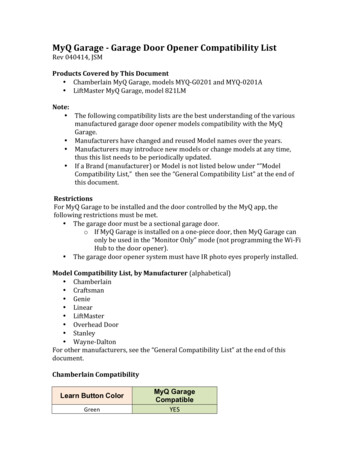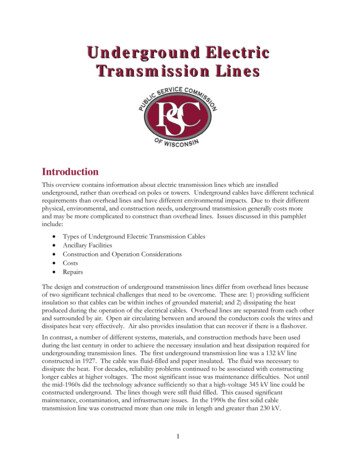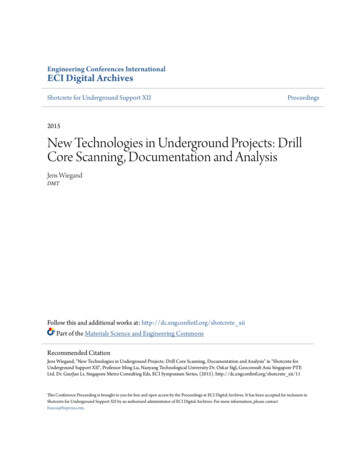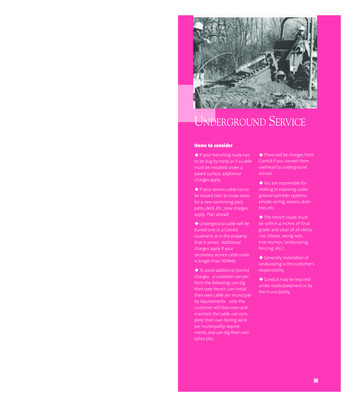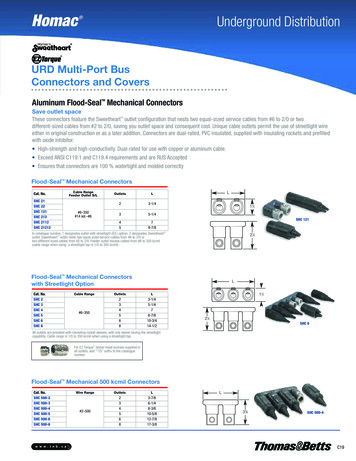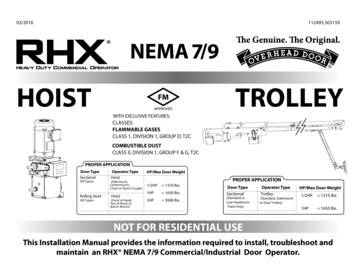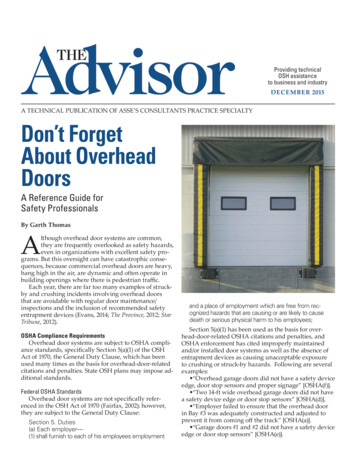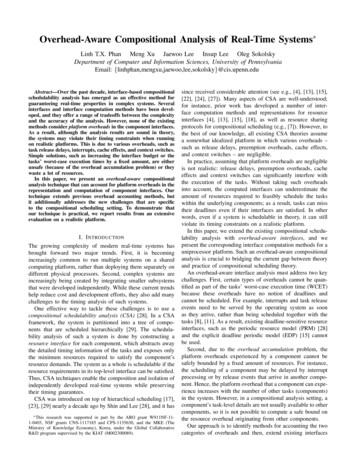
Transcription
Distribution Overhead andUnderground Operations andMaintenance ConferenceMarch 15-16, 2017Denver Marriott South at Park MeadowsLone Tree, COInstructed by:Clifton Boop, Supervisor, Distribution Operations, Technical Support, Arizona Public ServiceRobert Ousley, Supervisor, Distribution Operations Center, Arizona Public ServiceBill Menge, Director, SmartGrid, Kansas City Power & LightJoshua Jones, Director, T&D Standards Engineering, PacifiCorpMatt Wells, Operations Superintendent II, Colorado Springs UtilitiesDavid Tomczyszyn, Power System Consulting Engineer, Austin EnergyThomas Magee, Partner, Keller and Heckman LLPSanket Adhikari, Supervisor, Transmission Operations Engineering, Arizona Public ServiceMark Lesiw, Electric Standards Manager, Xcel EnergyBill Galloway, Standards Managing Engineer, Colorado Springs UtilitiesWiFi InformationNetwork: Marriott ConferencePassword: RMEL2017RMEL 6855 S. Havana, Ste 430 Centennial, CO 80112 (303) 865-5544 FAX: (303) 865-5548 www.RMEL.org
*Visit www.RMEL.org for the latest topic andspeaker information.CONFERENCE AgendaWednesday,March 15, 20178:30 a.m. - 9:15 a.m.Communicating FaultIndicatorsClifton Boop, Supervisor,Distribution Operations,Technical Support, ArizonaPublic ServiceRobert Ousley, Supervisor,Distribution OperationsCenter, Arizona Public ServiceThis presentation will coverutilization of communicatingfault indicators on the APSDistribution System. Thepresentation will includeinitial experience and use ofCFI’s in addition to updatesand most valuable strategyand locations we have foundfor them. We will cover thestrengths and weaknesseswe have discovered and continue to learn with deployingapproximately 800 devicesonto our system.9:15 a.m. 10:00 a.m.Distribution SCADA“Lite” without a SCADASystem and AutomaticReconfiguration ofDistribution System Aftera FaultBill Menge, Director,SmartGrid, Kansas City Power& LightAs part a “fork-lift” upgradeof the OMS System, KCP&Lintegrated monitoring andcontrol of DistributionAutomation (DA) equipmentdirectly into the OMS. Previously portions of the DAsystem were integrated intothe EMS SCADA system withother components operatedvia a web-based platform.Now Operators receivealarms and can control DAequipment DIRECTLY fromthe OMS without having tologin to other systems. Thisdramatically reduced thenumber and complexity ofthe interfaces required fordaily operations.10:00 a.m. - 10:15 a.m.1:00 p.m. - 2:45 p.m.10:15 a.m. - 11:15 a.m.Bring roundtable topicsfor discussion and/or sendtopics ahead of time tojamessakamoto@rmel.org.Roundtables offer a uniqueforum for peer-to-peer sharing of experiences, criticalissues and expertise. Theroundtable is a discussiongroup, open only to RMELmembers. Discussion isbased on topics brought byattendees. Roundtables arefocused on the open discussion period and provideeach attendee the opportunity for participation anddialogue on their particularissue. Roundtables areheld in conjunction with aconference and many topicspresented at the conferenceare discussed further inthe roundtable setting. Theroundtable is a good opportunity to share experiences,troubleshoot problemsand network with peers ina smaller, informal setting.Each participant is offereda chance to pose questionsand share information. Allattendees are encouraged tobring issues for discussionand materials for sharing.Networking BreakMobile Data & WorkforceManagement - A Discussion of Current UtilityDeployments and TrendsJoshua Jones, Director, T&DStandards Engineering,PacifiCorpMatt Wells, OperationsSuperintendent II, ColoradoSprings UtilitiesRobert Ousley, Supervisor,Distribution OperationsCenter, Arizona Public ServiceDavid Tomczyszyn, PowerSystem Consulting Engineer,Austin EnergyMany utilities are navigatingthrough the best practicesto maximize on mobile workforce management. Attendees will participate in openconversation regarding theircurrent utility deploymentsand trends.11:15 a.m. - NoonSmall Cell Attachments toUtility PolesThomas Magee, Partner,Keller and Heckman LLPThis presentation willdiscuss the regulatory andoperational issues pertainingto small cell wireless attachments to electric utilitypoles, and explain provisionsutility pole owners can useto protect themselves.12:00 p.m. - 1:00 p.m.Networking LunchDistribution Vital IssuesRoundtable2:45 p.m. - 3:00 p.m.Networking Break3:00 p.m. - 3:45 p.m.PacifiCorp’s Integrationof Distributed EnergyResources and ElectricVehiclesJoshua Jones, Director, T&DStandards Engineering,PacifiCorpThe electric utility industryis changing and in order toprovide the best service forour customers the traditionalelectric utility industry mustchange with it. Peopleinteract with our product inmuch different ways thanthey did in the past and nowexpect to see options in theproducts and services weprovide. PacifiCorp will bediscussing how they haveadapted their business toprovide distributed energyresource options and whatthey are doing to optimizethe integration of electricvehicles.3:45 p.m. - 4:30 p.m.APS Solar PartnerProgramSanket Adhikari, Supervisor,Transmission OperationsEngineering, Arizona PublicService CompanyIncreasing levels of rooftopPV penetration on distribution feeders in APS’s serviceterritory have introducedvarious challenges in the Distribution System. ThroughSolar Partner Program(SPP), APS is getting deeperunderstanding of these challenges and is researchingthe use of the technologieslike residential advancedinverters and feeder levelenergy storage to addressthese challenges. As part ofSPP, APS installed more than1500 utility owned residential rooftop PV systems fortotal of 10MW, all equippedwith smart inverters andcontrolled from a centralizedcontrol system. In addition,APS has also installed two2MWhr battery energy storage systems on two distribution feeders. APS has beenconducting an 18 month longresearch on these technologies in collaboration withElectric Power ResearchInstitute (EPRI). This presentation will inform aboutthe design and architectureof the program, challengesencountered, innovative solutions implemented and theinitial research findings.4:30 p.m. - 5:30 p.m.Networking Hour
Distribution Operations and Maintenance ConferenceIndustry Best Practices for Emerging Technologies. DevelopingTechnologies and Industry Practices as it Evolves Around UsThursday,March 16, 20178:00 a.m. - 9:30 a.m.Distribution Vital IssuesRoundtableBring roundtable topicsfor discussion and/or sendtopics ahead of time tojamessakamoto@rmel.org.9:30 a.m. - 9:45 a.m.Networking Break9:45 a.m. - 10:00 a.m.Attendee AnnouncementsAny registered attendeeis invited to make a shortannouncement on their company, new products, technologies or informationalupdates. Announcementsmay include showing aproduct sample but not videos and power point slides.Please limit announcementto 5 minutes.10:00-10:45 a.m.Making the Move to LEDLighting, What ShouldYou Be Thinking About?Mark Lesiw, ElectricStandards Manager, XcelEnergyUtilities across the UnitedStates have been upgrading traditional streetlightsto Light Emitting Diode(LED) technology. LED’s usesignificantly less energy thantraditional lighting and typically have much longer useful life spans. While makingthe switch to LED’s seems tobe a “no brainer”, as is oftenthe case, the upgrades toLED’s can get difficult once autility reviews the details ofthe numerous LED offerings.For example, recently theAmerican Medical Association issued a report claimingthere may be health and environmental concerns associated with certain LED’s. Thispresentation will detail thoseand other issues utilitiesmoving to LED streetlightsshould consider.10:45 a.m. - 11:30 a.m.2017 NESC Arc FlashUpdate and Methods toReduce Exposure WithoutIncreasing PPEBill Galloway, StandardsManaging Engineer, ColoradoSprings UtilitiesDavid Tomczyszyn, PowerSystem Consulting Engineer,Austin EnergyAn overview of the Arc Flashand PPE requirement changes affecting utilities in the2017 NESC. And examplesof how utilities are reducingpotential arc flash exposureto their employees withoutincreasing their PPE.Thank You RMEL DistributionCommitteeCHAIRBill GallowayColorado Springs UtilitiesStandards Managing EngineerVICE CHAIREbi KazemiBlack Hills CorporationManager, EngineeringAndy AlexanderKansas City Power & LightManager T&D Central DesignJohn ColeArizona Public ServiceSection Leader, Operations/MaintenanceBrent GerlingIndependence Power & LightDistribution EngineerJoshua JonesPacifiCorpDirector, T&D StandardsEngineeringMark LesiwXcel EnergyElectric Standards ManagerBryce PriestSRPSr. EngineerDavid TomczyszynAustin EnergyPower System ConsultingEngineerThe RMEL Distribution Committee plans all RMELDistribution events. If you’d like to send informationto the committee, email James Sakamoto atjamessakamoto@rmel.org.
Communicating Fault IndicatorsClifton BoopSupervisor, Distribution Operations, TechnicalSupportArizona Public ServiceRobert OusleySupervisor, Distribution Operations CenterArizona Public Service
Communicating Fault IndicatorsArizona Public ServiceClifton BoopSupervisor DOC Technical SupportRobert OusleySupervisor, DOC
Arizona Public Service CompanyTransmission & Distribution Overview APS Customers––––1.2 million customers11 out of 15 counties in Arizona35,000 square mile service territory6th largest service territory out of 150 investorowned utility operating companies reported by EEI* Transmission andDistribution Employees–––––––394Distribution Operations & Maintenance236Transmission Operations & Maintenance316Construction295Statewide Region116Safety & Performance Excellence148Engineering1,505 Total T&D employees Equipment––––––––34,601 Residential Solar systems installed (7/2015) 244 MWs residential PV/ 263 MWs Commercial PV6,000 transmission miles29,000 distribution miles521,000 poles302,000 transformers419 substations1,300 overhead and underground distribution feeders1,200 smart circuit devices deployed on over 250 feeders by 2015;devices include Communicating Fault indicators, automated switches,network protectors, volt/VAR control, Substation health monitors, etc.*2013 data2
Why the Grid Must ChangeTraditionalGridFlexibleGrid1-Way Power Flow2-Way Power FlowSeasonal VoltageSettingsDynamic VoltageVariabilityBase Load GenerationRenewableIntermittencyPlanning CriteriaSizing for erationMismatch3
Drivers For ChangeEnergy Independence, Distributed Energy,Utility Scale Solar, Electric Vehicles, Microgrids,and Demand ResponseSmart Phone Applications, Opt-inNotifications, Home EnergyManagement, Self-Service, ServiceOptions, and Customized eeds andExpectationsLess Customer Outages, ReducedRestoration Times, Improved PowerQuality, and Increased manceMicroprocessors, AdvancedApplications, Battery Storage, WirelessDevices, and Cloud eased Asset Life, ImprovedCapacity Factors, Reduced Losses,Improved Power Factors, andIncreased System Efficiencies4
APS 5-Year Technology Deployment PlanIntegrated Volt/VAR Control (IVVC)991 Devices on 153 FeedersSynchrophasors15 DevicesNetwork Protectors120 DevicesIntegrated OperatingCenter with AdvancedDistributionAMIManagement System 1.2 Million Meters DeployedEnergy ManagementSystem (EMS) UpgradesTransformer Load Management ToolRenewable Feeder ToolFire MitigationExpulsion Limiting FusesSupervisory Controlled Switches710 Devices on 284 FeedersCommunicating Fault Indicators (CFI)2,607 Devices on 568 FeedersVoltage VisualizationSubstation Health Monitoring579 Devices at 142 Substations5
STEPS TAKEN TO SUPPORT NEW TECHNOLOGY Metro & State area Operation Centersintegrated from 5 DOC’s into one centralizedOperation Center. (2014) Implemented ADMS January 2017 Best in Class Initiative (ongoing) Data Analytics
Overhead/Underground CFI’s
Construction & Installation The GridAdvisor Series II smart sensor consists of a sensor unit with an integraldual LED indicator powered by a rechargeable Lithium phosphate battery. Ruggedsolid-state construction ensures dependability and accuracy.Installation is quick and easy. No special tools are required. The sensor unit itselffeatures a clamping mechanism design that allows easy snap-on connection to thelive conductor with the use of a single hotstick.APS requirement is a minimum of 10 amps per phase continuous.Coordination between Engineer & Load Management Specialist /Planner to selectdevice locations.Feeders and locations selected based off reliability data, geographic accessibility,length, and some placed to compliment other SMG device locations.
Benefits The estimated benefit is derived from the following areas:––––––––Reduced Distribution Operations & Maintenance CostReduced Sustained Outages*Reduced Restoration CostReduced Lost Energy RevenueReduced Vehicle Safety EventsReduced Customer Outage Minutes*Narrowed patrol area after momentary outages*Increased confidence that troubleshooter will find cause *
Visualization Grid Advisor – SG Net CFI Application – Pi Processbook Pi Coresight
SG Net – Grid Advisor
CFI Application – Pi Processbook
Active loss of current
Pi Coresight
Pi Coresight
Current StateLocations: Total of 1152 devices at approximately 392different sites. (mixture of 1, 2, & 3-ph sites) Installing in conjunction with SCADAControlled Switches & other SG Devices.
Lessons Learned Location selection for battery charging Seasonal load areas Battery issues due to outages or lineconstruction in area. Ease of visualization for Operations Center
Battery Replacement
Questions?
Distribution SCADA “Lite” withouta SCADA System and AutomaticReconfiguration of DistributionSystem After a FaultBill MengeDirector, SmartGridKansas City Power & Light
RMEL Distribution Operations and Maintenance ConferenceMarch 15-16, 2017 Denver, ColoradoHow KCP&L Created a Distribution SCADA-Litewithout a Distribution SCADA SystemBill MengeSmart Grid DirectorKansas City Power & Light
KCP&L – Midsize Investor Owned Electric UtilityKey StatisticsCustomersGeography830,00018,000 sq miMissouri & KansasEmployees3,000 Generation6,600 MWDistribution Subs315Distribution Circuits16002
KCP&L – Midsize Investor Owned Electric UtilityKey StatisticsCustomersGeography830,00018,000 sq miMissouri & KansasEmployees3,000 Generation6,600 MWDistribution Subs315Distribution Circuits16003
KCP&L Capacitor Communications Timeline(significant to DA history)Tropos (12-14) 90% of capacitors are automated, reducingneed for time-based maintenance.FlexNet (2014)Telemetric Public Cellular (Analog, 2G, 3G)Cellnet 2-Way (ends 2015)TimelineCellnet AMREnergyline/IntellicapControls199395932-Way CapComms95Win Mon95WinmonQuery ToolNear UnityKCPL PFTC012ControlTC032ControlS-GridVVC DemoCBC-8000Control9702-0803101415Remote Settings - TuningKeyCommunicationsFunctionalityPink text isSmartGrid DemoFixed Bank Automation1999HawthornExplodesDynamic Voltage ControlGMO AutomationVVC DemoOMS Integ4
KCPL DA Device PopulationCapacitors – 2511 Cellnet 418 Cellular 1733 Flexnet 360UG Network - 134 All CellularOther - 20Reclosers - 120 All CellularIntellirupter- 12 All CellularVista – 13Trident – 1(SF6 in Vaults)(solid Dielectric in vault) All Cellular All CellularFCI – 268Regulators– 12 All Cellular All CellularTVM VoltageMonitor – 122 All Cellular50 CO & DVC – 203 Buses EMS Comms(50 CO is remote enabling of fasttrips. DVC is Voltage Reduction)Total Automated Devices: 3200(not including 50 CO and DVC)5
KCPL DA Devices w/ Sensus CommunicationsCapacitors – 2511 Cellnet 418 Cellular 1733 Flexnet 360UG Network - 134 All CellularOther - 20Reclosers - 120 All CellularIntellirupter- 12 All CellularVista – 13Trident – 1(SF6 in Vaults)(solid Dielectric in vault) All Cellular All CellularFCI – 268Regulators– 12 All Cellular All CellularTVM VoltageMonitor – 122 All Cellular50 CO & DVC – 203 Buses EMS Comms(50 CO is remote enabling of fasttrips. DVC is Voltage Reduction)Total Automated Devices: 3200(not including 50 CO and DVC)6
KCPL DA CommunicationsThree DA Communications Infrastructuresprior to Project Cellnet (retired 8/15/2015) Sensus (formerly Telemetric) Public Cellular Sensus Flexnet – Private CellularTROPOS wireless mesh was piloted in a SmartGrid Demo, but notselected for enterprise deployment.7
KCPL DA Communications History Various one-way pager pilots – 1980’s CellNet early 1990’s Metricom/UtiliNet radios – mid 1990’s Commercial Analog Radio – rural applic 2001 GPRS 2G Public Cellular – 2006 (Retires 2016) GPRS 3G Public Cellular – 2011 TROPOS – Piloted in SmartGrid Demonstration FlexNet – early applications – 2014In-use today.8
KCPL Distribution Platform ConsolidationWinmon(Cellnet ailNotificationDSO Dispatcher SystemsPrior toOMS-Phase-II D-SCADA-LiteSeparate Interfaces complicate life in the DSO(Distribution System Operations).Operators did NOT get consistent look & feel9
KCPL Distribution Platform ConsolidationEMSOMSDSO Dispatcher SystemsTODAY with D-SCADA-Lite Winmon Retired 8/15/2015 Sensus Website still available as a Backup (Heavy Engr use) Desire to Integrate EMS to OMS for Breaker StatusNow Operators get consistent look & feel10
Oracle NMS Viewer (DSCADA-Lite)Point & Click Screenswithin the OMS ViewerOperators getconsistent look & feel11
Legacy Integration to EMS SCADAEMS Replaced in 2015NO DA in SCADARetired in 201512
Pre-project State - 2014Flexv1FLEX v1AerisSXG net via KCPLSingle Sign-on2GSecure VPNDNP 3.0(ScadaXChange)I wish I could see andoperate all the DADevices thru my OMSwithout having to go toEMS SCADA or SensusWeb.3GPowerVistaWeb AppsDNP Proxy Server(“Bow Box”)KCPLEMS (SCADA)KCPL SCADALegacy OMS is COMPLETELY separated from all DA.Operating data has to be entered manually to OMS.13
Integrating DA Devices into New OMS (SCADA-Lite)Oracle NetworkManager System– KCPL OMSDNP3ICCPLiveData RTI Operates asReal-time OT Centric MiddlewarePlatform – reduces OT integration time.User-friendly Config tools.Sensus CloudPlatform IncludingSCADA-Xchange –Manages the FAN14
Current State – Live in 2Q 2015Flexv1FLEX v1AerisSXG ScadaXchangeSensusPVI’m so happy. I run OMSand SCADA-Lite from onescreen & I don’t care howit gets here.(PowerVista)SXG3G-CDMAATTInternet via KCPLSingle Sign-on2G3GPowerVistaWeb Apps(Mostly Engineering)Secure VPNDNP 3.0(ScadaXChange)KCPL OMS(Operations)Live DataKCPL OMSRTI Platform(Oracle NMS)Live DataOT Message Bus/Server(Redundant)ICCP(Not a SCADA System)Now Operators get consistent look & feel.OMS tracks the DA operating data.15
OMS DNP Point List/Testing – for DSOTotal DSO RequiredPointsAIDIDOTotal NMSAlarming PointsAIDI274176202DA, OMS, SE, LD, OR*Y225116321DA, OMS, SE, LD, OR, RL, UDY10550000DA, OMS, SE LD, ORY64173116202DA, OMS, SE, LD, OR, RLY76233116202DA, OMS, SE, LD, OR, RLY111010000DA, OMS, SE LD, ORY2961310000DA, OMS, SE LD, ORY183105000DA, OMS, SE LD, ORY37102403000000DA, OMS, SE LD, ORDA, OMS, SE LD, ORY?19676000DA, OMS, SE LD, ORYSC VistaGear160124202DA, OMS, SE LD, OR, RL?Pulse Recloser3820144404DA, OMS, SE LD, OR, RL?Nule ACR3110174202DA, OMS, SE LD, OR, RL?Nule ACO27999303DA, OMS, SE LD, OR, RL?Device TypeTC032ETI-Relay NetworkprotectorTC012Copper 34kvRecloser LSCopper 34kvRecloser LS2TVM3INT120S CapControlINT120 VARN CapControlT600/T646 (FCI)MJXLEL1000N CapControlSCADA Testing ResourcesTesting DeviceAvailability16
Control of Field Devices from OMSOperators get consistent look & feel17
OMS Alarming in Oracle NMSOperators get consistent look & feel18
Real Time Integration – Many Flexible OptionsOption BThird-PartySCADA SystemOption B.3Option B.1IEDSensusSCADA XchangeServerFCIDNP/TCP/IPSecure VPNOption B.2Live DataServer/OTMBDA DeviceCAPcontrolRecloserSmart IEDICCPOption ADADNP/TCP/IPRTPTCP/IPOption CKCPLOMS D-SCADA19
KCPL Potential Long Range RoadmapYVendor XHeadend or WebXXYZZIntegrate toEnd DevicesS-SlaveFLEX V2XFLEX V1Flex v1(or v2)Integrate to System(s)S-MasterSensusAC v3.?Power VistaComponentsleft off to b AppsKCPL OMS(Oracle NMS)(Not a SCADA System)KCPL OMS(Operations)Live Data(Redundant)LiveDataWeb Apps arepowerful tool forEngineering andare a built-inbackup system.4GLTE4G LTEAvailable 2015I’m extremely happy. I run OMS and SCADA-Lite from one terminal/screen & Idon’t have to care how it gets here AND Engineering can bring in devicesfrom all kinds of vendors for amazing operational functionality – usually withoutbothering KCPL-IT.I Love D-SCADA Lite!! – Why would I need to buy a D-Scada system?3GNo 2G in AC3G Via RepointATT Sunset 201820
Why Use Middleware (LiveData RTI)?LiveData’s RTI Platform/OT Message Bus Real-time OT centric middleware platform Ensure the protection of Life, equipment, environment Supports many utility protocols including: ICCP, DNP3, modbus, OPC, Web Services Python support, 50 built-in data filters and templating Faster OT system integrations Less risk, less cost, less one-off custom point-to-point solutions User-friendly Configuration tools Future-proof system integration More tolerant of lossy and messy radio networks21
Middleware ConfigTool Point and click ‒ easy dataflow configuration Simplifies the complexity of OT integration (use of templates) Robust change management for lifecycle control22
Middleware Config on KCP&L Project 90,000 data points Reduced to 30 templates Significant cost/timesavings relative to custominterface LiveData actively managesSensus/Oracle interface Data flow 138 feet by 8feet at full scale2323
QuestionsBill MengeSmart Grid DirectorKansas City Power & Light816-245-3926bill.mengea@kcpl.comA special Thank You to Tianling Wu, KCP&L DA Engineering – KCP&L’s project architect.
Small Cell Attachments to UtilityPolesThomas MageePartnerKeller and Heckman LLP
Small Cell Attachments to Utility PolesMarch 15, 2017Thomas B. Magee, PartnerKeller and Heckman LLPWashington, DC Office202.434.4128magee@khlaw.comCopyright 2017 www.khlaw.comKeller and Heckman LLP1
Overview What Are Small Cells and Why Are WeGoing to See A Lot More of Them? Regulation of Small Cell Attachments Contract/Rate/Construction StandardIssuesCopyright 2017 www.khlaw.comKeller and Heckman LLP2
Wireless Capacity Expansion Mobile Wireless Data Consumption toIncrease Six Fold by 2022 FCC Estimates New Small Cell AntennaConstruction Sites 100,000 to 150,000 by end of 2018 455,000 by 2020 Nearly 800,000 by 2026 Estimated 50% or More On Utility PolesCopyright 2017 www.khlaw.comKeller and Heckman LLP3
Small Cell MapCopyright 2017 www.khlaw.comKeller and Heckman LLP4
Typical Small Cell Deployment Fiber Attached to Every Pole Every 6-15 Poles – “Node” Pole: Antenna2.5 Foot CabinetWire Connecting Cabinet to AntennaElectric Distribution Panel120V, 20A GFCI Work ReceptacleElectric MeterWork LightCopyright 2017 www.khlaw.comKeller and Heckman LLP5
AT&T on a Utility PoleCopyright 2017 www.khlaw.comKeller and Heckman LLP6
Crown Castle in Princeton, NJCopyright 2017 www.khlaw.comKeller and Heckman LLP7
Crown Castle in Franklin Village, MICopyright 2017 www.khlaw.comKeller and Heckman LLP8
Crown Castle Pole in Broward Cty, FLCopyright 2017 www.khlaw.comKeller and Heckman LLP9
Sprint in Detroit, MICopyright 2017 www.khlaw.comKeller and Heckman LLP10
Crown Castle on Utility PolesCopyright 2017 www.khlaw.comKeller and Heckman LLP11
Crown Castle Pole Multi-CarrierCopyright 2017 www.khlaw.comKeller and Heckman LLP12
Cable Wi-FiCopyright 2017 www.khlaw.comKeller and Heckman LLP13
Strand-Mounted Cable Wi-FiCopyright 2017 www.khlaw.comKeller and Heckman LLP14
Pole Attachment Act 47 U.S.C. 224 FCC Regulates Attachments to IOUPoles in 30 States State Regulation in 20 and Wash, D.C. Some Regulate Co-op & Muni Poles FCC Regulations Often Followed byStatesCopyright 2017 www.khlaw.comKeller and Heckman LLP15
Pole Attachment Act Applies to Cable & Telecom Cos. Wireless Telecom Qualifies Non-discriminatory Access to Poles,Ducts, Conduits and Rights-of-Way Regulated Rates Can Deny Access for Capacity, Safety,Reliability & Engineering ReasonsCopyright 2017 www.khlaw.comKeller and Heckman LLP16
Poles Covered Distribution PolesNot Street Light-Only PolesNot Street Light ArmsNot Transmission-Only Towers But w/Distribution Under-build?Copyright 2017 www.khlaw.comKeller and Heckman LLP17
Types of Wireless Companies CMRS ProvidersDAS CompaniesWISPSInfrastructure-Only AttachersCable Company WiFi/WirelessBroadbandCopyright 2017 www.khlaw.comKeller and Heckman LLP18
FCC Small Cell ProceedingNovember 2016Mobilitie Petition Claims Local Gov’t SiteApproval Slow and ExpensiveDecember 2016FCC Asks for Comments on How toStreamline Local Gov’t ReviewCopyright 2017 www.khlaw.comKeller and Heckman LLP19
State Small Cell Legislation Legislation Introduced 17 States (so far) Limit Local Gov’t Review Time and ROWAccess Fees Some Set Attachment Rates to MuniPoles Two Would Have Affected Co-op Poles Most Envision Wireless Cos. InstallingOwn PolesCopyright 2017 www.khlaw.comKeller and Heckman LLP20
Construction Standards Primary Voltage Poles – Pole Top Access? Poles with Reclosers, Sectionalizers,Capacitors, Regulators, Multiple Risers,Other Large Equipment? Truck Accessible Adequate Strength/Space for Installation? Maintain Climbing Space Grounded Antenna Equipment On/Off Pole?Copyright 2017 www.khlaw.comKeller and Heckman LLP21
Radiofrequency Radiation Issues Maximum Permissible ExposureCompliance? Interference With Utility Wireless? Certification by Telecom Engineer On/Off Switch Posting of RF Signs Citizen OppositionCopyright 2017 www.khlaw.comKeller and Heckman LLP22
Rates FCC Requires Cost-BasedCalifornia PUC FormulaPole Top Different?What if Replace Pole?Copyright 2017 www.khlaw.comKeller and Heckman LLP23
Wireless Attachment Contract Issues Application Process, Identification andApproval Installation and Maintenance Radiofrequency Interference and ExposureTesting, Mitigation, Notifications andCertification Authorized Uses and AccessLandowner/Government AuthorizationsAttachment Fees and PenaltiesIndemnifications and Other SafeguardsCopyright 2017 www.khlaw.comKeller and Heckman LLP24
Don’t We Have Enough Stuff Already?Copyright 2017 www.khlaw.comKeller and Heckman LLP25
THANK YOUThomas B. Magee, PartnerKeller and Heckman LLPWashington, DC Office202.434.4128magee@khlaw.comWashington, DC Brussels San Francisco Shanghai ParisCopyright 2017 r26
PacifiCorp’s Integration ofDistributed Energy Resources andElectric VehiclesJoshua JonesDirector, T&D Standards EngineeringPacifiCorp
A Grid In TransitionJoshua Jones, PEDirector, T&D Standards
About PacifiCorp Customers1.8 millionEmployees5,700Territory143,000 sq. mi.Distribution64,000 Line MilesTransmission16,500 Line MilesGeneration 72 Plants 10,894 MW Capacity2
A Century of Service Salt Lake City was the fifthcity in the world to havecentral station electricitybehind only London, NewYork City, San Francisco andCleveland. Rocky Mountain Powerdates back to 1881. PacifiCorp is thecombination of 368companies3
Primary Voltages 2.4kV4.16kv7.2kV11.5kV12kV 115kV 138kV161kV230kV345kV500kVThat’s 20 primary supply voltages.4
Total Responsibility Generation– Coal/Gas/Wind/Solar/Geothermal Substation Distribution– Overhead NESC and GO95Network System– Underground NESC and GO128– Network Transmission– Overhead– Underground Communications5
The TransitionEfficientEffective How fast can you build a substation /transmission line / distribution line How to buy the hardware at the bestprice How to prevent customer impact frommotor starts, flicker, power quality How to defer investments withdistributed energy resources How to find good manufacturers in aglobal economy How do we work with our customersto avoid impacts.Our customers need to work with us! What do our customers value andhow can we provide that?6
Improving Customer ReliabilityVisual IndicationDirectional IndicationCommunicating
Improving Customer Reliability8
Improving Customer ReliabilityLoss of CurrentNo AlarmRecloserFault Indicator9
Integrating Distributed Generation10
Customer Rooftop Generation11
Handling Reverse Power Flow Without distributed energy resources– Energy flows from utilityto the customer With distributed energy resources– Energy flows to and fromthe customer dependingon the time of day andtheir consumption Voltage control is independent ofcurrent flow1212
Maintain Customers Voltage Service voltage bandwidth ANSI Range A– Nominal /-5% for secondary deliveryVoltage126Line regulator120114Length13
Voltage Control Modes14
Integrating Distributed GenerationTraditional Regulator Control– Single phase controller– Available reverse power flows would notallow regulation in the reverse mode– Regulation is blocked during reverse powerflowCo-generation Regulator Controls– Source and load PTs are required– Allows regulation in the reverse power flow: BlockRegulateLine drop compensationAdjust bands15
Bi-directional ReclosersLine Reclosers– Fault settings Forward Reverse– Load/source voltage sensors– Communication enabledGeneration Reclosers– Transfer-trip capabilities– Generation/load shedding– Dead-line check16
Improve Reliability /
APS Solar Partner Program Sanket Adhikari, Supervisor, Transmission Operations Engineering, Arizona Public Service Company Increasing levels of rooftop PV penetration on distribu-tion feeders in APS's service territory have introduced various challenges in the Dis-tribution System. Through Solar Partner Program (SPP), APS is getting deeper
